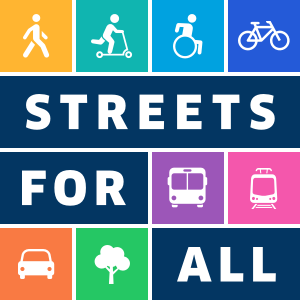Slow Streets have been approved in Los Angeles! Thank you to everyone that helped make it happen.
A few tips for Slow Street Applications:
You need a sponsoring organization (can be the neighborhood council or any local org).
Use this tool to build your route and figure out which streets are eligible. Keep it to ~25 intersections and/or 2 miles. If there’s a street that’s labeled a “collector” but otherwise perfect, let them know. They can be flexible.
Make sure you have a few volunteers to help monitor things and report problems to LADOT.
Create easy ways for the community to give feedback and be responsive to it. Here’s an example of a survey; you could also create a special email address (ex. slowstreets@____.org).
🚲 🛴 🚶🏾 👩🏻🦽 🌳
Our Ask:
For the critical reasons of equity, mental health, safety, and the physical well-being of Angelenos, we ask the City of LA to authorize the pilot of an emergency people street network - using cones or other temporary infrastructure - to create additional sidewalk and open space for people to walk, run, scoot, and bike in, while maintaining 6’ of distancing.
These space redistributions may follow existing models such as emergency protected lanes, hard “CicLAvia-esque” street closures, or local play streets. They may also advance the Mayor’s goals under L.A.’s Green New Deal to “Activate Streets” and “Prioritize Land Use and the Right-of-Way” in Executive Directive 25.
Oakland “Slow Streets” treatment (Photo courtesy of City of Oakland)
Why is this necessary?
COVID-19 has wreaked havoc on the City of Los Angeles, disrupting lives, costing lives, and severely hampering our economy. Despite all the disruption, essential workers still need to get to and from their place of work, while maintaining 6’ of distance between each other. People also still need to get to and from critical doctor appointments, pick up prescription medication, and access groceries and food centers. Making active transportation safer can provide all Angelenos mobility alternatives, especially those without access to a vehicle.
Los Angeles would be in good company, as cities large and small across the US have taken similar emergency measures to insure people can safely provide critical goods and services as well as maintain physical and mental health while avoiding spreading the virus. Examples include Minneapolis, Oakland, Denver, San Francisco, Boston, Brookline, Cleveland, Philadelphia, Burlington, Duluth, Edmonton, Louisville, Portland, New York, St. Louis, and St. Paul. As summer weather is nearly here in Los Angeles, and keeping people strictly indoors becomes even more challenging, it’s critical now more than ever that we follow suit. In England medical professionals called for the government to enable safe walking and cycling during the COVID-19 pandemic.
All Angelenos should be able to maintain their physical and mental health during this pandemic. Park space comes at a premium in Los Angeles, with many neighborhoods lacking access at a reasonable per capita rate. L.A. County’s 2016 Park Need Assessment found 28 of the 42 studied neighborhoods in the City of Los Angeles had “Very High” or “High” need. This amounts to millions of residents who can’t access local parks without crowding, and more often than not overlap with areas of concentrated poverty, obesity, asthma, particulate matter, and the city’s High Injury Network. Many Angelenos - those most vulnerable according to the City’s community equity and health index - live in denser areas next to major arteries and have no safe spaces for much needed maintenance of psychological and physical health. (Map)
The road space in Los Angeles is now dramatically overbuilt for the current vehicle traffic volume, causing vehicles to travel at dangerous speeds, up 30% on many now wide open roads according to LADOT. At the same time, the average width of our sidewalks is 4.4’, too narrow to allow two people to pass each other while maintaining 6’ of distance. As a result, people are forced to be in close proximity with each other, risking proliferating the virus or walking, running, scooting, or biking in the street next to speeding cars. This isn’t just a street safety issue, but a public health issue as well.
Strategies to quickly reduce human contact are necessary, but finding long term strategies to keep Angelenos mentally and physically healthy while the city shelters-in-place for the next couple months cannot be overlooked. Globally, we’re already seeing impacts in places with harsh lock-down strategies. Isolation and inactivity can lead to increases in chronic health conditions like heart disease and obesity and pose other mental and physical health risks that we may pay for as a society for years to come.
Specifically, we see this proposal fulfilling the following public health solutions:
Increase access to local public space for active social distancing while alleviating crowding.
Reinforcing connections to grocery stores, hospitals, LAUSD food centers, delivery services, and other essential resources, especially for non-car-owners.
Increase equitable access to outdoors, active transportation, cardiovascular exercise, and sustaining both physical and mental health.
Slow down streets that are seeing increased speeding, improving traffic safety (Vision Zero), and minimizing the unnecessary use of stretched medical resources to respond to accidents.
Change context of park space in LA from a crowded destination to a locally accessible resource.
Create a safe 6’ distanced option for active transportation as an alternative to the busiest transit routes.


